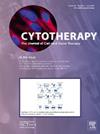TissueGene-C induces anti-inflammatory activity and M2 macrophage polarization via activation of prostaglandin E2 signaling
IF 3.7
3区 医学
Q2 BIOTECHNOLOGY & APPLIED MICROBIOLOGY
引用次数: 0
Abstract
Background and Aim
Osteoarthritis (OA) is the most common form of degenerative joint disease that commonly affects the knees, hips and hands. OA is a mechano-inflammatory disease characterized by low-grade inflammation, which results in breakdown of the cartilage extracellular matrix within joints, leading to pain, stiffness and inflammation. TissueGene-C (TG-C) is a cell and gene therapy investigational drug for treating knee OA that comprises human allogeneic chondrocytes and an irradiated modified cell line stably expressing transforming growth factor beta 1 (TGF-β1). Previous pre-clinical animal studies have shown that TG-C provides pain relief via its anti-inflammatory effects and cartilage structural improvement in a rat OA model. The goal of this study was to investigate the mechanism of action of TG-C, explore its anti-inflammatory activity and identify the TG-C–derived active factor(s) responsible for its efficacy.
Methods
In this study, we utilized THP-1 cell line to develop an macrophage polarization model to test the anti-inflammatory activity of TG-C.
Results
Our data showed that TG-C induces the polarization of M2 macrophages and the upregulation of interleukin 10 (IL-10) and interleukin 1 receptor antagonist (IL-1ra) while inhibiting tumor necrosis factor alpha (TNF-α) expression. Additionally, this study identified prostaglandin E2 (PGE2) as the main bioactive factor responsible for the anti-inflammatory activity of TG-C.
Conclusions
Our results demonstrated that PGE2 is expressed by the TG-C chondrocyte component and modulated by TGF-β1 derived from the second component of TG-C. Finally, the present study provides insight into the mechanism of action of TG-C in the treatment of OA.
tisegene - c通过激活前列腺素E2信号通路诱导抗炎活性和M2巨噬细胞极化。
背景和目的:骨关节炎(OA)是最常见的退行性关节疾病,通常影响膝关节、髋关节和手部。骨性关节炎是一种以低度炎症为特征的机械炎性疾病,其结果是关节内软骨细胞外基质的破坏,导致疼痛、僵硬和炎症。TissueGene-C (TG-C)是一种用于治疗膝关节OA的细胞和基因治疗研究药物,由人异体软骨细胞和稳定表达转化生长因子β1 (TGF-β1)的辐照修饰细胞系组成。先前的临床前动物研究表明,TG-C通过其抗炎作用和改善大鼠OA模型的软骨结构来缓解疼痛。本研究旨在探讨TG-C的作用机制,探索其抗炎活性,并确定其作用的TG-C源性活性因子。方法:本研究利用THP-1细胞系建立巨噬细胞极化模型,检测TG-C的抗炎活性。结果:我们的数据显示,TG-C诱导M2巨噬细胞极化,上调白细胞介素10 (IL-10)和白细胞介素1受体拮抗剂(IL-1ra),抑制肿瘤坏死因子α (TNF-α)的表达。此外,本研究发现前列腺素E2 (PGE2)是TG-C抗炎活性的主要生物活性因子。结论:我们的研究结果表明,PGE2由TG-C软骨细胞组分表达,并由TG-C第二组分衍生的TGF-β1调节。最后,本研究提供了TG-C在OA治疗中的作用机制。
本文章由计算机程序翻译,如有差异,请以英文原文为准。
求助全文
约1分钟内获得全文
求助全文
来源期刊

Cytotherapy
医学-生物工程与应用微生物
CiteScore
6.30
自引率
4.40%
发文量
683
审稿时长
49 days
期刊介绍:
The journal brings readers the latest developments in the fast moving field of cellular therapy in man. This includes cell therapy for cancer, immune disorders, inherited diseases, tissue repair and regenerative medicine. The journal covers the science, translational development and treatment with variety of cell types including hematopoietic stem cells, immune cells (dendritic cells, NK, cells, T cells, antigen presenting cells) mesenchymal stromal cells, adipose cells, nerve, muscle, vascular and endothelial cells, and induced pluripotential stem cells. We also welcome manuscripts on subcellular derivatives such as exosomes. A specific focus is on translational research that brings cell therapy to the clinic. Cytotherapy publishes original papers, reviews, position papers editorials, commentaries and letters to the editor. We welcome "Protocols in Cytotherapy" bringing standard operating procedure for production specific cell types for clinical use within the reach of the readership.
 求助内容:
求助内容: 应助结果提醒方式:
应助结果提醒方式:


